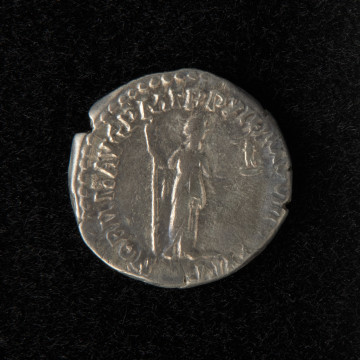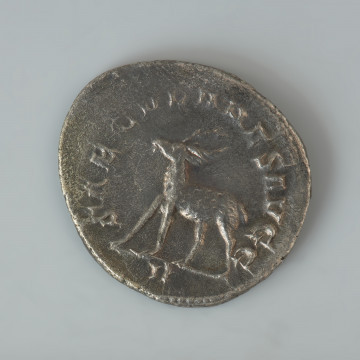
Denarius of Commodus
177 — 192
National Museum in Szczecin
Part of the collection: Antiquity
The follis of Constantine I (Gaius Flavius Valerius Constantinus, lived 272-337, reign years 306-337) was minted for his son Constantine II in the years 325-326. The follis is well preserved, although the inscriptions are partially illegible. The obverse shows a portrait of Constantine II as a child (he was about 9-10 years old when the coin was made), in left profile, wearing a laurel wreath and armour on his shoulders. The image is surrounded by the inscription CONSTANTINVS IVN NOB C. The reverse shows a depiction of a military camp gate with two turrets and a star between them. It is encircled by the inscription PROVIDEN TIAE CAESS. At the bottom, there is an illegible mint stamp, probably S M C, an abbreviation for the then Kyikos in the area of today’s Erdek, Turkey. The coin comes from a hoard of follis found by chance before 1920. The hoard originally consisted of about 250 follis of Constantine I, but only 50 specimens have survived to the present day. The oldest coin is dated to 313-315, while the youngest is dated to 328-329. The coins were produced mainly in Trier, Arles and Lugdunum. Follis were bronze coins introduced by Diocletian in 294. Their name is traditional and literally means “leaf” (thin layer of metal) (Latin: follis). Coins of low value were kept in sealed pouches of fixed weight which were used in transactions. Follis were also minted in Byzantium and the Arabic countries.
Bartłomiej Rogalski
Author / creator
Dimensions
cały obiekt: diameter: 10 mm
Object type
exchaneg media; money; coin; follis
Technique
forming; punching
Material
bronze
Creation time / dating
Creation / finding place
Owner
Muzeum Narodowe w Szczecinie
Identification number
Location / status

177 — 192
National Museum in Szczecin

National Museum in Szczecin

476 — 491
National Museum in Szczecin
DISCOVER this TOPIC
National Museum in Szczecin
DISCOVER this PATH
Educational path